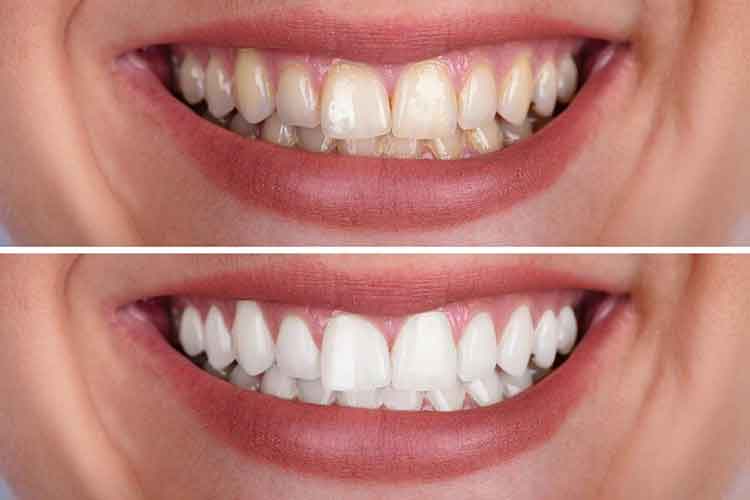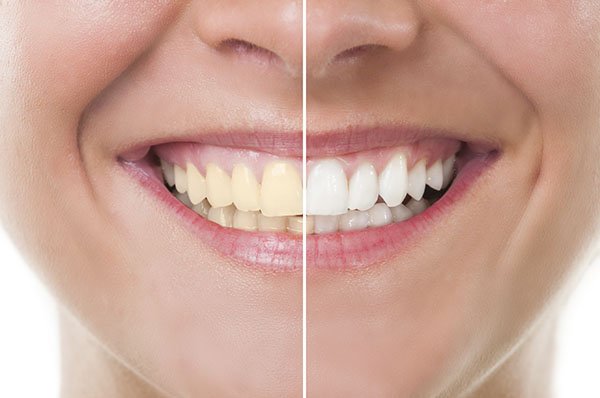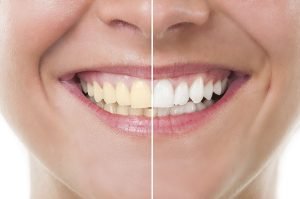To get rid of yellow teeth, practice good oral hygiene and consider professional teeth whitening. Home remedies like baking soda and hydrogen peroxide can also help.
Yellow teeth can be a source of self-consciousness and hinder a confident smile. Over time, our teeth may discolor due to various factors like diet, smoking, and poor dental care. Whiter teeth are often associated with health and beauty, driving many to seek ways to brighten their smile.
With the rise of cosmetic dentistry and at-home teeth whitening kits, achieving pearly whites has become more accessible. It’s essential, though, to choose safe and effective methods to avoid damaging your enamel. This introduction sets the stage for an exploration of simple yet powerful tactics to combat yellowing teeth, ensuring readers can find practical solutions that fit their lifestyles and budgets. By maintaining consistent and proper oral care routines, individuals can significantly improve and maintain their dental aesthetics.

Credit: www.signaturesmilesparker.com
Introduction To Yellow Teeth
Yellow teeth can diminish confidence and prompt dental health concerns. Discover effective methods to restore your smile’s natural whiteness and maintain enamel strength with practical teeth-whitening solutions.
Smile brightness often fades over time, leading to yellow teeth. Many seek ways to restore their pearly whites. This post explores the causes and effects of yellow teeth. It includes steps to reclaim a bright smile.
Understanding The Causes Of Yellow Teeth
Yellow tinges on teeth come from various sources. These include:
- Food and Drink: Coffee, tea, and red wine have intense color pigments called chromogens.
- Tobacco Use: Tar and nicotine create stubborn stains on teeth surfaces.
- Poor Dental Hygiene: Inadequate brushing allows plaque and stain-producing substances to build up.
- Age: Over time, the outer enamel layer gets thinner revealing the yellow dentin beneath.
- Medications: Certain antihistamines, antipsychotics, and high blood pressure medications can cause tooth discoloration.
The Impact Of Yellow Teeth On Oral Health And Self-esteem
Yellow teeth affect more than your smile. They can also impact overall oral health and self-esteem.
| Oral Health | Self-Esteem |
|---|---|
| Can signal plaque build-up or tooth decay | May lead to reduced confidence in social situations |
| May result in gum disease risk if not addressed | Can cause hesitation to smile freely |
Teeth whitening, improved dental hygiene, and lifestyle changes can help. This guide offers actionable tips to achieve a brighter smile.
Preventive Measures
Flashing a smile with confidence starts with pearly white teeth. Preventive measures play a crucial role in maintaining that sparkle. Simple changes to daily habits can save you from the trouble of yellow teeth. Let’s dive into the best practices that help preserve a gleaming smile.
Daily Oral Hygiene Best Practices
To fend off yellow stains, a strict oral routine is vital. Brush twice daily and use fluoride toothpaste for strong, white teeth. Don’t skip on flossing either; it removes hidden plaque that toothbrushes miss. Also, include mouthwash to reach where brush and floss can’t. It not only freshens breath but also fights discoloration.
- Brush for two minutes
- Floss daily
- Use mouthwash
- Change your toothbrush every three months
Dietary Changes To Prevent Tooth Discoloration
What you eat impacts your smile. Cut down on teeth-staining foods like coffee, red wine, and soda. Instead, munch on crunchy veggies and fruits; they scrub your teeth naturally. Remember, if it can stain a white shirt, it can stain your teeth.
| Eat Less | Eat More |
|---|---|
| Coffee | Carrots |
| Red Wine | Apples |
| Soda | Celery |
Regular Dental Check-ups And Cleanings
To spot potential issues early, visit the dentist regularly. A professional cleaning every six months can remove surface stains and prevent tartar build-up. Your dentist can also catch signs of decay early, stopping yellowing at its source.
- Book biannual dental appointments
- Get professional cleanings
- Ask for dental sealants
Professional Dental Treatments
Seeking a brighter smile? Dental professionals offer advanced treatments to effectively combat yellow teeth. These procedures promise more significant results than at-home methods. Explore the professional options below for a radiant smile.
In-Office Teeth Whitening OptionsIn-office Teeth Whitening Options
Dentists provide quick whitening solutions right in the clinic. Here’s what they involve:
- High-concentration bleaching agents applied carefully.
- Special lights or lasers used to enhance results.
- Results often visible immediately after one session.
Dental Veneers For Persistent Stains
Dental veneers are custom-made shells designed to cover the tooth’s front surface. Benefits include:
| Material | Durability | Appearance |
|---|---|---|
| Porcelain or resin | Long-lasting | Natural look |
They are a go-to for tough stains or discoloration not solved by whitening treatments.
Bleaching Trays and Gels: When to Consider Professional HelpBleaching Trays And Gels: When To Consider Professional Help
Take-home kits from dentists offer a balance between at-home ease and professional-grade results. Consider professional bleaching trays and gels when:
- Over-the-counter options do not work.
- Seeking customized fit for better coverage.
- Desiring dentist oversight for safety and effectiveness.
Home Remedies And Natural Solutions
Many people desire a brighter smile, and home remedies offer natural solutions. These remedies don’t need frequent trips to the dentist or fancy products. Each option is simple to try at home.
The Role Of Baking Soda And Hydrogen Peroxide
Baking soda acts as a mild abrasive, gently polishing away surface stains on teeth. When mixed with hydrogen peroxide, it creates a paste.
Here’s how to use them:
- Mix a small amount of baking soda with hydrogen peroxide.
- Create a paste.
- Apply it to your teeth using a soft-bristled toothbrush.
- Brush gently for two minutes.
- Rinse thoroughly with water.
Use this method twice a week for the best results.
Oil Pulling: An Ancient Practice Revisited
Oil pulling is a traditional remedy that involves swishing oil in the mouth. It removes toxins and improves oral health.
- Choose an oil (coconut, sesame, or olive).
- Swish a tablespoon in your mouth for 15-20 minutes.
- Do not swallow the oil.
- Rinse with warm water afterwards.
Repeat this process daily before brushing your teeth.
Fruit Peels And Other Natural Whiteners
Some fruits have natural enzymes that can help whiten teeth.
| Fruit | Method |
|---|---|
| Banana | Rub the inside of the peel on your teeth for two minutes. |
| Strawberry | Mash and apply to teeth. Leave for five minutes, then rinse. |
| Orange | Rub the peel directly onto your teeth. |
After using fruit peels, brush your teeth to remove any sugar.
Over-the-counter Products
For those eager to flash a brighter smile, over-the-counter products offer an array of solutions. From whitening toothpaste to strips, the options are plentiful. Yet, knowing which will deliver the shine you desire without a trip to the dentist is key. Discover how these products can help banish yellow stains and restore your teeth’s natural sparkle.
Selecting The Right Whitening Toothpaste
Not all toothpastes are equal when it comes to whitening. When shopping, look for a whitening toothpaste that has the American Dental Association (ADA) Seal of Acceptance. This ensures it’s safe and effective. The active ingredients break down stains gently, polishing your teeth to their natural whiteness.
- Ingredients such as hydrogen peroxide and baking soda are common
- Check for minimal abrasiveness to protect enamel
- Twice daily brushing enhances results
Teeth Whitening Strips: Do They Work?
Indeed, whitening strips are a popular product. They are thin, transparent strips coated with a peroxide-based gel. Applying them to your teeth for the recommended time can lift stains effectively. Results can be visible within a few days and often last for months.
| Use Frequency | Expected Results | Duration of Effect |
|---|---|---|
| Daily | Whiter teeth in several days | Months |
Rinses And Mouthwashes For Daily Use
To supplement your whitening routine, consider adding a daily rinse or mouthwash. These products often contain ingredients to combat yellowing. With consistent use, they can help maintain the results of other whitening treatments.
- Choose mouthwashes with hydrogen peroxide for whitening
- Use them as directed, typically twice a day
- Pair with whitening toothpaste for optimal effects

Credit: bondidental.com.au
Lifestyle Changes For Brighter Teeth
A smile speaks volumes, and bright teeth add confidence to every word. Yellow teeth can dim your smile’s sparkle. Simple shifts in daily habits can rejuvenate your teeth’s natural glow. Embrace these modifications for a luminous smile and healthier you.
Quitting Smoking And Limiting Stain-causing Beverages
- Quit smoking: Smoking contributes to tooth discoloration. Tobacco leaves stubborn stains difficult to remove through brushing. Abstain from smoking for brighter teeth.
- Reduce coffee, tea, and red wine: These drinks can stain your teeth. Enjoy in moderation. Use a straw for cold beverages to bypass your front teeth.
- Rinse after consuming: Rinse your mouth with water after drinking stain-causing beverages, reducing their staining effect.
Importance Of Hydration And Saliva Production
Staying hydrated isn’t just good for your health; it’s crucial for your teeth. Water flushes away food and bacteria that lead to yellow teeth. A dry mouth lacks saliva which naturally cleanses your teeth. Drink up for a dazzling smile.
Chewing Sugar-free Gum To Promote Oral Health
Chewing sugar-free gum boosts saliva production. More saliva means cleaner teeth. It washes away food debris and neutralizes harmful acids. For fresh breath and a whiter smile, pop a piece of sugar-free gum after meals.
Understanding The Risks
Yellow teeth often call for treatments to brighten your smile. Users consider teeth whitening a quick fix. It’s essential to know what these methods entail. Risks are part of the process, and understanding them helps ensure a safe journey to a whiter smile. Below are some considerations to keep in mind before undergoing whitening methods.
Possible Side Effects Of Teeth Whitening
Seeking a dazzling smile may come with unexpected side effects. Users frequently report increased tooth sensitivity post-treatment. Some experience gum irritation. In certain cases, overuse leads to enamel damage or uneven whitening. Consulting a dentist helps minimize these risks. They can advise on proper use and suitable products.
When To Avoid Certain Teeth Whitening Methods
- Pregnant women should postpone whitening.
- People with sensitive gums or worn enamel need caution.
- When braces are present, it’s best to wait.
- Underlying dental issues require treatment first.
Managing Sensitivity After Whitening Treatments
After treatments, teeth may feel sensitive. This is common. To reduce discomfort, use sensitivity toothpaste. Fluoride rinses also help. Avoiding extremely hot or cold foods prevents triggering sensitivity. Lastly, follow instructions closely. Use whitening products as directed. This minimizes sensitivity and other side effects.

Credit: bondidental.com.au
Long-term Maintenance
Once you’ve brightened your smile, keeping those pearly whites shining is key. Long-term maintenance isn’t just a phase; it’s a lifestyle. Commit to this, and your teeth will thank you. Protect your hard work and investment with these essential steps.
Continuing Good Oral Hygiene Habits
Regular care is the cornerstone of lasting tooth whiteness. Brush twice a day and floss daily to remove plaque and prevent stains.
- Choose whitening toothpaste occasionally to deal with surface stains.
- Limit stain-causing foods and drinks like coffee, red wine, and berries.
- Use a straw for beverages to keep them from touching the front teeth.
- Regular dental cleanings are crucial. Visit your dentist every six months.
Touch-up Treatments: Frequency And Methods
The need for touch-up treatments depends on your habits and the chosen whitening method. Some require them yearly, others less frequently.
| Whitening Method | Suggested Frequency |
|---|---|
| Whitening Strips | Every 6 Months |
| Whitening Toothpaste | Once per Month |
| Professional Treatments | Every 1-2 Years |
Consider natural methods, like brushing with baking soda, for gentle, periodic maintenance.
Monitoring Changes And Communicating With Your Dentist
Pay close attention to your teeth’s color and sensitivity. Keep a photo record to compare changes over time.
- Watch for new stains and treat them early.
- Note sensitivity after treatments, and discuss them with your dentist.
- Attend regular check-ups; professional eyes catch things you might miss.
Open dialogue with your dentist is critical. They can tailor advice and treatments for your unique smile.
Exploring Cosmetic Alternatives
Welcome to “Exploring Cosmetic Alternatives,” an essential guide for anyone looking to enhance their smile and banish yellow teeth. A bright, white smile boosts confidence and makes a lasting impression. Dental advancements offer an array of solutions to help achieve that gleaming grin.
When To Consider Cosmetic Dentistry
Cosmetic dentistry becomes a priority when regular cleaning and whitening products fail to deliver results. Discoloration from coffee, wine, smoking, or medication may need professional intervention. Understanding the available procedures ensures a well-informed choice.
The Benefits Of Bonding And Contouring
Bonding and contouring offer a minimally invasive approach to correcting stained teeth. The procedure involves applying a tooth-colored resin to improve color and reshape teeth. Benefits include:
- Quick results – often completed in one visit
- Cost-effective – a budget-friendly option when compared to veneers
- Painless procedure – no anesthesia required
Comparing The Cost And Effectiveness Of Different Procedures
Determining the right procedure involves comparing costs and effectiveness. Options vary from over-the-counter products to professional treatments. Below is a comparison:
| Treatment | Average Cost | Effectiveness | Treatment Time |
|---|---|---|---|
| Whitening Strips | Low | Moderate | 1-2 weeks |
| Professional Whitening | Medium | High | 1-2 hours |
| Veneers | High | Very High | Multiple Visits |
| Bonding and Contouring | Low to Medium | High | 1 visit |
Choosing the right treatment depends on personal needs, budget, and desired outcome. Consultation with a dental professional provides tailored advice.
Closing Thoughts On A Whiter Smile
A bright, white smile boosts confidence and leaves a lasting impression. Yet achieving and maintaining this can be a challenge. Your journey to a whiter smile is ongoing, relying on daily habits, proper dental care, and sometimes professional treatments. Consider the discussions on causes and remedies as a roadmap to keeping your teeth gleaming.
Summarizing Key Points For Maintaining White Teeth
- Brush twice a day to remove surface stains.
- Floss regularly to prevent plaque buildup.
- Use whitening toothpaste once a week.
- Avoid stain-causing foods and drinks like coffee and red wine.
- Seek regular dental check-ups for professional advice and cleaning.
Future Trends In Dental Whitening
Dental whitening technology is rapidly evolving. Experts predict various trends to emerge:
- Natural solutions will gain popularity for their gentle effects.
- New whitening gels may work faster with less sensitivity.
- LED and laser treatments will advance, becoming more accessible.
- Emerging research may introduce innovative techniques for lasting whiteness.
This field will continue to grow, offering diverse options for anyone seeking a brighter smile.
Conclusion
Embracing a brighter smile is within reach by tackling yellow teeth with these strategies. Remember, consistency is key in any oral care routine. Tap into the power of proper brushing, lifestyle changes, and professional treatments. Smile with confidence, knowing these effective tips will keep your pearly whites shining.

